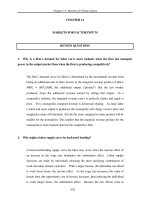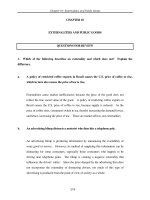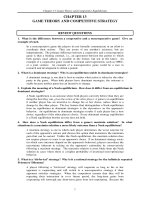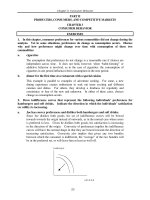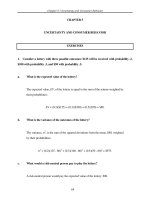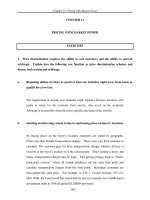Tài liệu Câu hỏi đánh giá môn Kinh tế vĩ mô bằng tiếng Anh- Chương 3 pdf
Bạn đang xem bản rút gọn của tài liệu. Xem và tải ngay bản đầy đủ của tài liệu tại đây (72.89 KB, 11 trang )
Chapter 3: Consumer Behavior
23
PART II
PRODUCERS, CONSUMERS, AND COMPETITIVE MARKETS
CHAPTER 3
CONSUMER BEHAVIOR
QUESTIONS FOR REVIEW
1. What are the four basic assumptions about individual preferences? Explain the
significance or meaning of each.
Chapter 3: Consumer Behavior
24
(1) Preferences are complete: this means that the consumer is able to compare
and rank all possible baskets; (2) Preferences are transitive: this means that
preferences are consistent, in that if bundle A is preferred to bundle B and bundle
B is preferred to bundle C, then we should be able to conclude that bundle A is
preferred to bundle C; (3) More is preferred to less: this means that all goods are
desirable, and that the consumer will always prefer to have more of a good; (4)
Diminishing marginal rate of substitution: this means that indifference curves
are convex, and that the slope of the indifference curve increases (becomes less
negative) as we move down along the curve. As a consumer moves down along
her indifference curve she is willing to give up fewer units of the good on the
vertical axis in exchange for one more unit of the good on the horizontal axis.
This assumption also means that balanced market baskets are preferred to baskets
that have a lot of one good and very little of the other good.
2. Can a set of indifference curves be upward sloping? If so, what would this tell you
about the two goods?
A set of indifference curves can be upward sloping if we violate assumption
number three; more is preferred to less. When a set of indifference curves is
upward sloping, it means one of the goods is a “bad” in that the consumer prefers
less of the good rather than more of the good. The positive slope means that the
consumer will accept more of the bad good only if she also receives more of the
other good in return. As we move up along the indifference curve the consumer
has more of the good she likes, and also more of the good she does not like.
3. Explain why two indifference curves cannot intersect.
Chapter 3: Consumer Behavior
The explanation is most easily achieved with the aid of a graph such as Figure 3.3,
which shows two indifference curves intersecting at point A. We know from the
definition of an indifference curve that a consumer has the same level of utility
along any given curve. In this case, the consumer is indifferent between bundles A
and B because they both lie on indifference curve U
1
. Similarly, the consumer is
indifferent between bundles A and C because they both lie on indifference curve U
2
.
By the transitivity of preferences this consumer should also be indifferent between
C and B. However, we see from the graph that C lies above B, so C must be
preferred to B. Thus, the fact that indifference curves cannot intersect is proven.
Good Y
Good X
A
C
B
U
1
U
2
Figure 3.3
4. Jon is always willing to trade one can of coke for one can of sprite, or one can of sprite
for one can of coke.
a. What can you say about Jon’s marginal rate of substitution?
25
Chapter 3: Consumer Behavior
26
Jon’s marginal rate of substitution can be defined as the number of cans of coke
he would be willing to give up in exchange for a can of sprite. Since he is
always willing to trade one for one, his MRS is equal to 1.
b. Draw a set of indifference curves for Jon.
Since Jon is always willing to trade one can of coke for one can of sprite, his
indifference curves are linear with a slope of –1.
c. Draw two budget lines with different slopes and illustrate the satisfaction-
maximizing choice. What conclusion can you draw?
Jon’s indifference curves are linear with a slope of –1. Jon’s budget line is also
linear, and will have a slope that reflects the ratio of the two prices. If Jon’s
budget line is steeper than his indifference curves then he will choose to consume
only the good on the vertical axis. If Jon’s budget line is flatter than his
indifference curves then he will choose to consumer only the good on the
horizontal axis. Jon will always choose a corner solution, unless his budget line
has the same slope as his indifference curves. In this case any combination of
Sprite and Coke that uses up his entire income with maximize his satisfaction.
Chapter 3: Consumer Behavior
27
5. What happens to the marginal rate of substitution as you move along a convex
indifference curve? A linear indifference curve?
The MRS measures how much of a good you are willing to give up in exchange
for one more unit of the other good, keeping utility constant. The MRS
diminishes along a convex indifference curve in that as you move down along the
indifference curve, you are willing to give up less and less of the one good in
exchange for the other. The MRS is also the slope of the indifference curve,
which increases (becomes less negative) as you move down along the indifference
curve. The MRS is constant along a linear indifference curve, since in this case
the slope does not change. The consumer is always willing to trade the same
number of units of one good in exchange for the other.
6. Explain why an MRS between two goods must equal the ratio of the price of the goods
for the consumer to achieve maximum satisfaction.
The MRS describes the rate at which the consumer is willing to trade one good for
another to maintain the same level of satisfaction. The ratio of prices describes the
trade-off that the market is willing to make between the same two goods. The
tangency of the indifference curve with the budget line represents the point at which
the trade-offs are equal and consumer satisfaction is maximized. If the MRS
between two goods is not equal to the ratio of prices, then the consumer could trade
one good for another at market prices to obtain higher levels of satisfaction. For
example, if the slope of the budget line (the ratio of the prices) is –4 then the
consumer can trade 4 units of good 2 for one unit of good 1. If the MRS at the
current bundle is –6, then the consumer is willing to trade 6 units of good 2 for one
unit of good 1. Since the two slopes are not equal the consumer is not maximizing
Chapter 3: Consumer Behavior
28
her satisfaction. The consumer is willing to trade 6 but only has to trade 4, so she
should make the trade. This trading continues until the highest level of satisfaction
is achieved. As trades are made, the MRS will change and become equal to the
price ratio.
7. Describe the indifference curves associated with two goods that are perfect substitutes.
What if they are perfect complements?
Two goods are perfect substitutes if the MRS of one for another is a constant
number. Given the MRS is a constant number, the slope of the indifference
curves will be constant, and the indifference curves are therefore linear. If two
goods are perfect complements, the indifference curves are L-shaped. In this
case the consumer wants to consume the two goods in a fixed proportion, say one
unit of good 1 for every 1 unit of good 2. If she has more of one good but not
more of the other then she does not get any extra satisfaction.
8. What is the difference between ordinal utility and cardinal utility? Explain why the
assumption of cardinal utility is not needed in order to rank consumer choices.
Ordinal utility implies an ordering among alternatives without regard for intensity
of preference. For example, if the consumer’s first choice is preferred to their
second choice, then utility from the first choice will be higher than utility from the
second choice. How much higher is not important. An ordinal utility function
generates a ranking of bundles and no meaning is given to the utility number itself.
Cardinal utility implies that the intensity of preferences may be quantified, and that
the utility number itself has meaning. An ordinal ranking is all that is needed to
Chapter 3: Consumer Behavior
29
rank consumer choices. It is not necessary to know how intensely a consumer
prefers basket A over basket B; it is enough to know that A is preferred to B.
9. Upon merging with the West German economy, East German consumers indicated a
preference for Mercedes-Benz automobiles over Volkswagens. However, when they
converted their savings into deutsche marks, they flocked to Volkswagen dealerships.
How can you explain this apparent paradox?
Three assumptions are required to address this question: 1) that a Mercedes costs
more than a Volkswagen; 2) that the East German consumers’ utility function
comprises two goods, automobiles and all other goods evaluated in deutsche marks;
and 3) that East Germans have incomes. Based on these assumptions, we can
surmise that while East German consumers may prefer a Mercedes to a
Volkswagen, they either cannot afford a Mercedes or they prefer a bundle of other
goods plus a Volkswagen to a Mercedes alone. While the marginal utility of
consuming a Mercedes exceeds the marginal utility of consuming a Volkswagen,
the consumer will consider marginal utility per dollar for each good. This means
the marginal utility per dollar must have been higher for the Volkswagen since
consumers flocked to the Volkswagen dealerships and not the Mercedes
dealerships.
10. Draw a budget line and then draw an indifference curve to illustrate the satisfaction
maximizing choice associated with two products. Use your graph to answer the following
questions.
a. Suppose that one of the products is rationed. Explain why the consumer is likely to
be worse off.
When goods are not rationed, the consumer is able to choose the satisfaction-
maximizing bundle where the slope of the budget line is equal to the slope of the
indifference curve, or the price ratio is equal to the MRS. This is point A in the
Chapter 3: Consumer Behavior
graph below. If good 1 is now rationed the consumer will not be able to attain
the utility maximizing point. He or she will have to consume more of the other
good instead. This is point B below.
good 1
U
1
U
2
A
B
b. Suppose now that the price of one of the products is fixed at a level below the
current price. As a result, the consumer is not able to purchase as much as she
would like of the product. Can you tell if the consumer is better off or worse off?
When the price of the good is fixed at a level below the current (equilibrium)
price, there will be a shortage of the good and the good will have to be effectively
rationed. As in the question above, the consumer is worse off because she is not
able to attain her utility maximizing point.
11. Based on his preferences, Bill is willing to trade 4 movie tickets for 1 ticket to a
basketball game. If movie tickets cost $8 each and a ticket to the basketball game costs
$40, should Bill make the trade? Why or why not?
30
Chapter 3: Consumer Behavior
No Bill should not make the trade. If he gives up the 4 movie tickets then he
will save $8 per ticket for a total of $32. However, this is not enough for a
basketball ticket. He would in fact have to give up 5 movie tickets if he wanted
to buy another basketball ticket. Notice also, that the marginal utility per dollar
is higher for movie tickets so Bill will be better off if he consumes more movie
tickets and fewer basketball tickets. To figure this out recall that what Bill is
willing to do defines his MRS. His MRS is 4 so this means that the marginal
utility of a basketball game is 4 and the marginal utility of a movie is 1:
MRS =−4 =−
M
U
ball
MU
movie
=−
4
1
.
Now the marginal utility per dollar can be computed:
M
U
ball
P
ball
=
4
40
=
1
10
MU
movie
P
movie
=
1
8
.
12. Describe the equal marginal principle. Explain why this principle may not hold if
increasing marginal utility is associated with the consumption of one or both goods.
The equal marginal principle states that the ratio of the marginal utility to price must
be equal across all goods to obtain maximum satisfaction. In other words, utility
maximization is achieved when the budget is allocated so that the marginal utility
per dollar of expenditure is the same for each good. If the marginal utility per
dollar is not equal then utility can be increased by allocating more dollars to the
good with the higher marginal utility per dollar. The consumer will obtain more
“bang for the buck” if they reallocate their dollars.
31
Chapter 3: Consumer Behavior
32
If marginal utility is increasing, the consumer maximizes satisfaction by consuming
ever larger amounts of the good. Thus, the consumer would spend all income on
one good, assuming a constant price, resulting in a corner solution. With a corner
solution, the equal marginal principle cannot hold.
13. The price of computers has fallen substantially over the past two decades. Use this
drop in price to explain why the Consumer Price Index is likely to overstate substantially
the cost-of-living index for individuals who use computers intensively.
The consumer price index measures the cost of a typical basket of goods purchased
by the consumer in the current year relative to the cost of the basket in the base
year. Each good in the basket is assigned a weight, which reflects the importance
of the good to the consumer, and the weights are kept fixed from year to year. The
problem with fixing the weights is that consumers will shift their purchases from
year to year to give more weight to goods whose prices have fallen, and less weight
to goods whose prices have risen. The CPI will therefore give too much weight to
goods whose prices have risen, and too little weight to goods whose prices have
fallen. For the individual who uses computers intensively, the fixed weight for
computers in the basket will understate the importance of this good, and will hence
understate the effect of the fall in the price of computers. The CPI will overstate
the rise in the cost of living for this type of individual.
14. Explain why the Paasche index will generally understate the ideal cost-of-living index.
The Paasche index measures the current cost of the current bundle of goods
relative to the base year cost of the current bundle of goods. The Paasche index
will understate the ideal cost of living because it assumes the individual will buy
the current year bundle in the base period. In reality, at base year prices the
consumer would have been able to attain the same level of utility at a lower cost
Chapter 3: Consumer Behavior
33
by altering their consumption bundle. Since the base year cost is overstated, the
denominator will be larger and the index will be lower, or understated.
